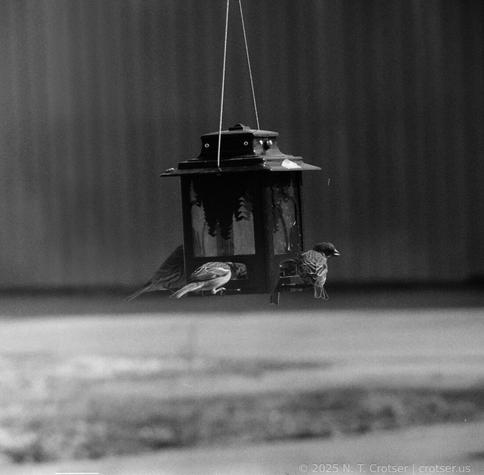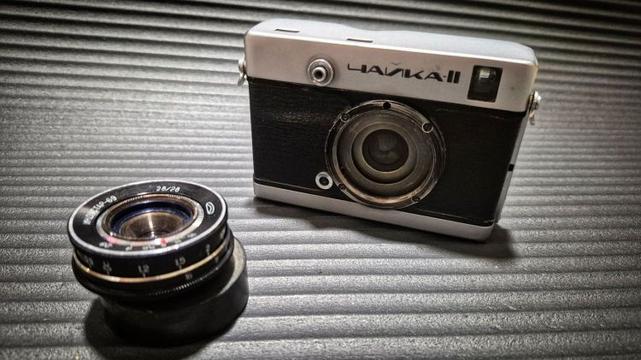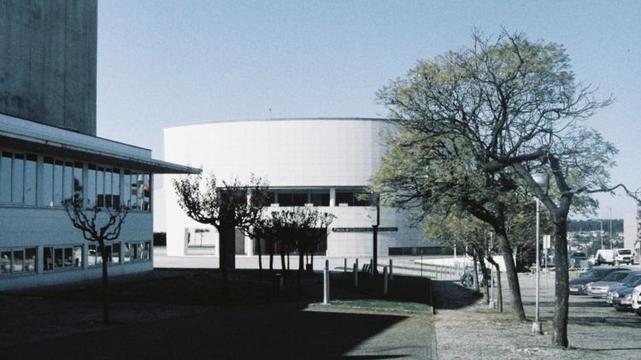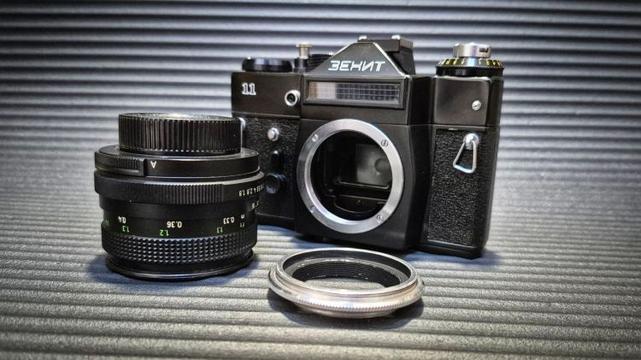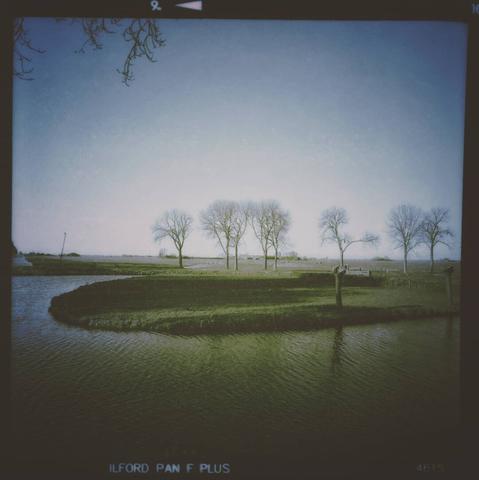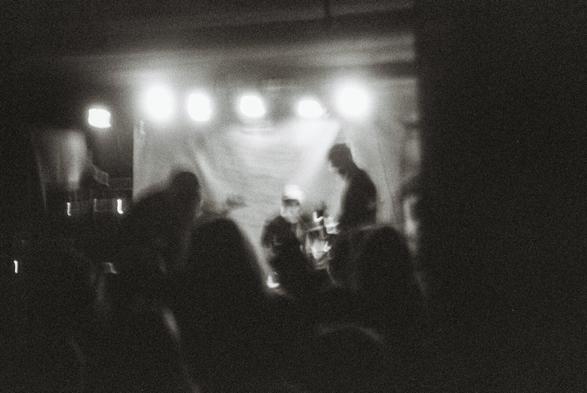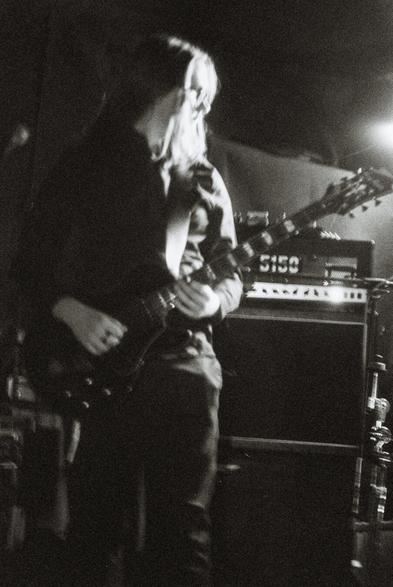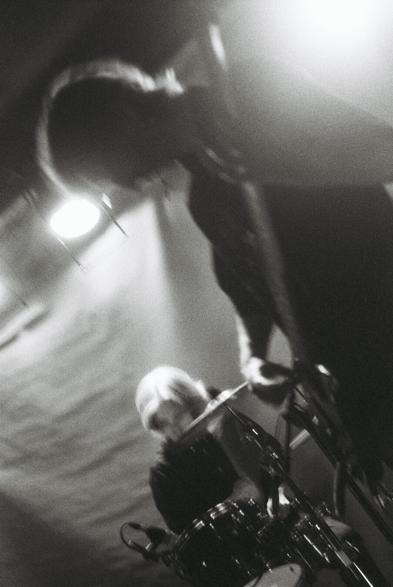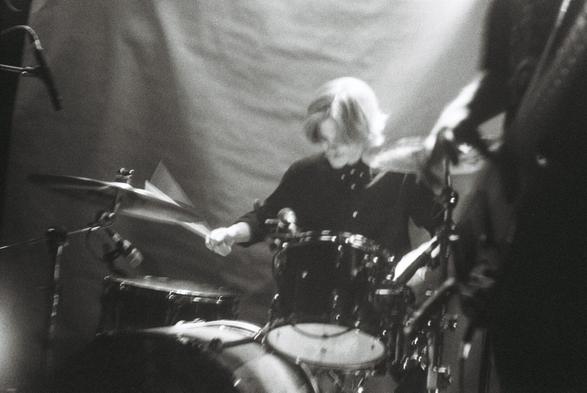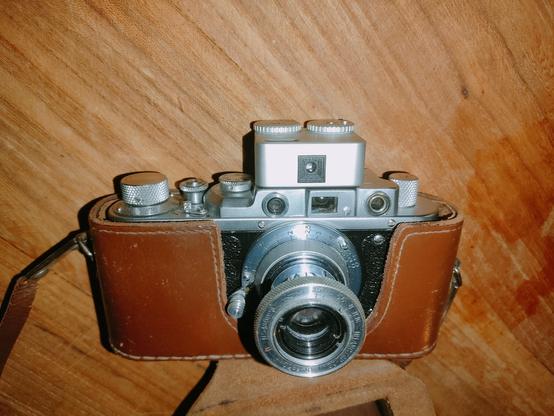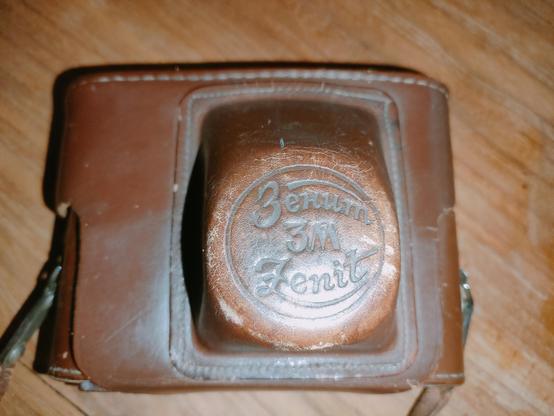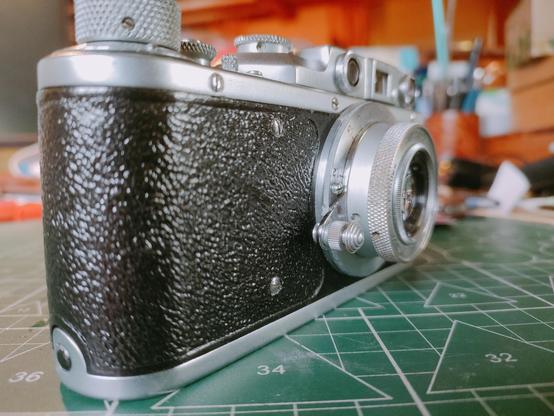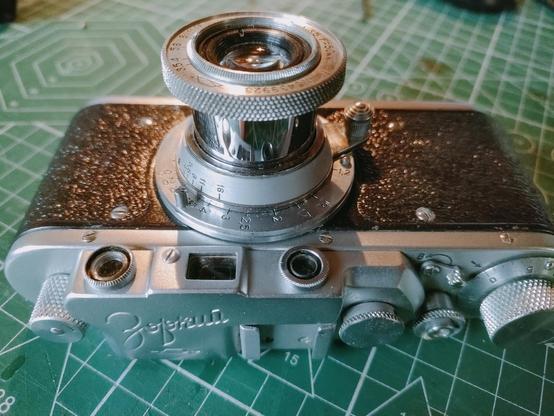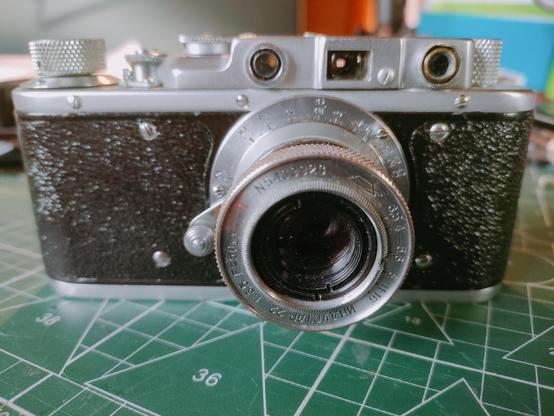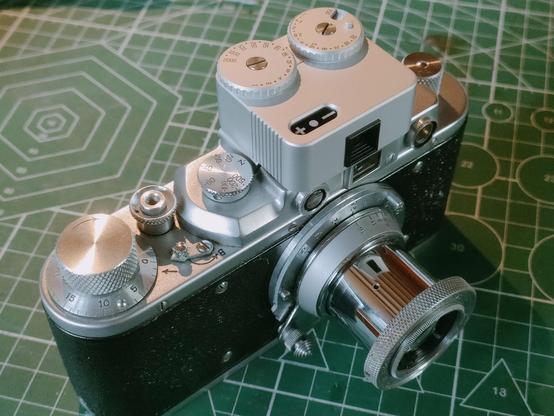#SovietCamera
📷: Zenit TTL
🎞: Arista Ultra 200
🧪: Cinestill D96
#filmisnotdead #AristaEDU200 #filmphotography #handsoff #35mm #BelieveInFilm #bwphotography #analogphotography #naturephotography #sovietcamera #cinestill
Another Contender for The Crappy Commie Camera Challenge: The Chaika II Half-frame Camera
I came across this one by accident (if ever anything is ‘accidental’ when I’m browsing the Kamerastore website), and as it’s a half-frame camera there was instant appeal. It also has a lovely little 28mm pancake lens and I was immediately wanting to try this M39-mount lens on my micro four-thirds cameras, but more on that later.
The Chaika II is a heavy beast, weighing over 300g and made of metal with plastic innards. It features shutter speeds of 1/30s, 1/60s, 1/125s, 1/250s and B, and the interchangeable 28mm lens has apertures from f2.8 to f16. The Chaika II was made by Belomo in Minsk, then in the Soviet Union, between 1967 and 1972. It was called Chaika, meaning ‘seagull’ after the call-sign of cosmonaut Valentina Tereshkova, the first woman in space.
My model was in the ‘Not Passed’ category on the Kamerastore website and has ‘flaws that will affect typical use’. In this case, there ‘is fungus on the inner lens elements’, though the camera body itself is fully functional. I was interested in this model for two reasons: It was made in the Soviet Union, which is ideal for the upcoming Crappy Commie Camera Party (CCCP), and it’s a half-frame camera, and I’m really getting into half-frame at the moment with the Welta Penti II (which itself is fully CCCP compliant).
The camera body is fully functional, and is in nice condition. Like any Soviet era camera that I’ve ever had it has some unique features that make it an interesting user experience. For a start, the shutter button is on the front of the camera, just above the lens assembly. This is actually quite good, as when you are holding the camera your fingers are automatically directed away from the lens. The shutter speed is set from a little dial on the back of the camera, near the viewfinder, and the speed is visible through a little window on the top plate.
Like other Soviet cameras I have, like the Smena 8M, and the KMZ Horizont, the rewind knob is tucked away. In this case on the bottom of the camera combined with the film speed dial. If you pull on the knob and turn it clockwise it locks open. Then you can twist the knob to rewind the film.
Because it’s a half-frame camera, and I don’t really have the patience to use 72 frames on a 36 exposure roll, I used an ‘off-cut’ of Harman Phoenix film after respooling some film into Rapid canisters. This gave me a length of film equivalent to about 15 frames, which for me was ideal to test the camera, and a technique that I might use in the future.
For a camera that was supposed to be filled with fungus the images came out great! I will certainly have to get out the lens spanner and see if I can clean the elements, and the Harman Phoenix gave some strange colour shifts, but I really liked the results.
Oh, and about that business of wanting to use the M39 lens from the Chaika II with my micro four-thirds mirrorless cameras. That looks like it’s a non-starter, unfortunately. Apparently, the camera/lens combination was designed to be used with an Belomo enlarger that never actually materialised. So it’s not really an interchangeable lens camera but a dedicated half-frame lens that was could be removed and mounted in an enlarger. From what I gather, you can hack the lens so that it will focus to infinity on micro four-thirds cameras, but that means that the lens won’t then function properly on the Chaika II. So that’s not really something I want to do.
If you are on Mastodon, you can now follow this blog directly. Just go to Mastodon and follow the ‘Snapshot’ WordPress account at @keithdevereux.wordpress.com. All new posts will be automatically updated to your timeline.
#Belomo #CCCP #Chaika #Chaika2 #CrappyCommieCameraParty #HalfFrame #M39 #MadeInUSSR #Seagull #SovietCamera
Gearing up for the Crappy Commie Camera Party, Part 2: Testing The Zenit 11, a Soviet-era Single Lens Reflex Camera
At the beginning of March I picked up a Zenit 11 single lens reflex (SLR) camera for the Crappy Commie Camera Party (CCCP). In the first post, ‘Gearing up for the Crappy Commie Camera Party’, I introduced the camera and ran through some of its … features. In this post, I managed to take the camera out on a rare sunny day and put it through its paces.
Although it was in the ‘Not Passed’ category of the Kamerastore website, with ‘flaws that will affect typical use’, in this case it was just the ‘light meter doesn’t work properly … Otherwise it is in good working condition!’ I also picked up two extra lenses, a CCCP compliant Industar-50-2, and a Cosina 50mm f1.8 lens, since the aperture on my Pentacon 50mm f1.8 lens is stuck at the widest aperture position and it turned out that even at its fastest shutter speed the camera would overexpose most films.
To test the camera I found an old roll of Lomochrome Metropolis that I’ve had sitting around for a few years now. I reckon this expired around 2022, but it’s new enough that I didn’t really think it needed much exposure adjustment so I exposed it at ISO 100, at the low end of the ISO 100-400 range of this film. To measure the exposure I used the smartphone app Light Meter.
Images taken with the Cosina 50mm f1.8 lens came out really well. I set the aperture on ‘auto’ mode, and the app suggested an exposure of 1/125s at f16. Looking at the final images, I think that the app is overexposing by around 1 stop, which I have noticed before and always seem to forget, so next time I might try adjusting the exposure accordingly.
Along with the Zenit 11 I bought an M42 lens reverse ring for macro photography. On one side is the M42 thread that screws into the camera, on the other side is a 49mm filter thread that fits the Pentacon and the Cosina. With the Cosina mounted on the reversing ring, I set the aperture to f16 in manual mode and tried some close up photography. Again this came out really well, and the macro photographs showed some really nice detail in the images. With a 50mm lens, the macro scale is roughly life-size, so I think I’m going to get some nice close ups with these during the CCCP challenge.
Finally, I wondered if I could use my homemade Deakinizer with the Zenit 11. If you’re not familiar with the Deakinizer, it was a lens invented by cinematographer Roger Deakins that creates an image with a clear centre to the frame and blurred edges. A cheap way to make a Deakinizer is to hold a wide-angle converter reversed in front of a camera lens, and I have a Panavision wide-angle converter just for this purpose.
The filter thread of the Panavision is 67mm, so I created a 49-67mm step up attachment to fix the Deakinizer to the front of the Cosina lens. At the full aperture the image looked great, with a fairly sharp centre and blurred edges. However, when the aperture was stopped down to f16, the image was restricted to the centre of the frame. It did work, though, and I really liked how these came out. What I have done is to order a 6-stop neutral density filter that should allow me to use a 50mm lens fully open at f1.8 with the Deakinizer. One of the benefits of this arrangement is that I’ll be able to use the Zenit with the CCCP-compliant Pentacon lens, and not the Cosina.
In conclusion, I was really happy with how the Zenit 11 performed and it’s certainly a camera to be used with the CCCP. I have recently obtained another Soviet made camera, the half-frame Chaika II, and I’ll be posting how this performed shortly.
If you are on Mastodon, you can now follow this blog directly. Just go to Mastodon and follow the ‘Snapshot’ WordPress account at @keithdevereux.wordpress.com. All new posts will be automatically updated to your timeline..
#CrappyCommieCameraParty #Deakinizer #M42MountVintageCamera #Macro #Pentacon #Retro #Shittycamerachallenge #SovietCamera #Zenit11
Gearing up for the Crappy Commie Camera Party, Part 1: The Zenit 11
Starting in June 2025 is the next iteration of the Shitty Camera Challenge, the Crappy Commie Camera Party (or CCCP for short). It’s intended to be a celebration of all things Soviet made, so Soviet-era cameras up to the fall of the Berlin Wall, about 1989.
Now I have plenty of Soviet era cameras, more in fact than I had thought. There’s the stereo Lomo Sputnik with its single working shutter speed, the wonderful Smena 8M, the (still untried) Cosmic Symbol, the panoramic Horizont, and a couple of Lomo LC-As. Oh, and not forgetting the Rapid format Lomo Smena SL. So I have plenty of options to choose from. But then, as always happens, chance intervened.
Just recently, Harman Technology released a new emulsion, Harman Red. This is a redscaled version of Harman Phoenix, and I was lucky enough to get my hands on a few rolls of pre-production Harman Red thanks to their Marketing department, who had seen and liked some of my own attempts at redscaling Phoenix. After its release, a user on Bluesky posted some wonderful macro images with Harman Red, and I was really taken with these as I had previously thought about trying to do something similar. The snag is, I don’t have any analogue cameras that can make decent macro images.
Coincidentally, one of my mutuals on BlueSky posted about her experiments with freelensing using redscale film, and of course that I really wanted to try. I’ve attempted freelensing before, where you disengage the camera lens from the body and hold it a couple of cm, or less, away from the camera. I’d even tried reversing the lens, which can result in some lovely dreamy looking macro images. The snag is that these have always been digital, and I’m really scared of getting dust on my digital sensors.
I had already considered combining the CCCP with a bit of freelensing, but dismissed it as I already have enough old Soviet era cameras to play with. But then my mutual friend played her ‘ace’ card: ‘I think it would really suit your experimental approach’, she wrote, and of course after laying down that challenge I just had to reconsider. I turned to the Kamerastore website, the source of all my crappy cameras, and searched for Zenit. Several options popped up, but this jet black Zenit 11, with Cyrillic writing really caught my eye.
It was in the ‘Not Passed’ category, with ‘flaws that will affect typical use’, but in this case it was that the ‘light meter doesn’t work properly and the light seals should be changed. Otherwise it is in good working condition!’ Well, then, that was perfect. I should add that back in the day, when I was looking for my first ‘real’ film camera (an SLR in those days, without the ‘D’), I would scour the adverts in Amateur Photographer looking for the best deal. There were loads of options for Zenits and Prakticas, but I dismissed those out of hand, and went for a Canon instead. What would my 20-something-year-old me think of that today?
At nearly 700g, the Zenit 11 is a heavyweight. Indeed, it’s been likened to a Russian tank in many a YouTube review. It’s a manual focus 35mm SLR camera produced in the Soviet Union from 1981 to 1990. The Zenit features shutter speeds from 1/30s-1/500s (+ B, and 1/30s is also the flash sync speed) and the meter can be dialled in for film speeds from ISO 25-400. The actual production date of the camera can be determined from the first two numbers of the serial number, and mine was made in 1986.
Like most Soviet cameras it has its little foibles, in this case how the exposure is measured through the selenium cell window on the front of the pentagram, and the means of disengaging the wind-on to rewind the film once it’s fully exposed. Other than that it’s a fairly straightforward single lens reflex camera. It uses the common M42 screw thread, and at the time it came with a Helios-44M f/2 58mm lens. These are quite highly sought after nowadays, mainly because the front or rear lenses can be flipped for spectacular bokeh effects.
My Zenit 11 didn’t come with a lens, but I have a Pentacon 50mm f1.8 lens that since it was made in East Germany, is also ‘CCCP compliant’. This lens was also from the ‘Not Passed’ category on the Kamerastore website — the aperture is stuck at the widest aperture position — and though I thought this wasn’t an obstacle, it turned out that even at its fastest shutter speed the camera would be over exposing most films. I therefore needed a ‘Plan B’.
I turned back to the Kamerastore website and found two contenders: A Cosina 50mm f1.8 Cosinon Auto lens, and an Industar 50-2, a 50mm f3.5 lens. The Cosina lens was in the ‘Not Passed’ category, with ‘some scratches on the outer elements and may affect the image quality … [and the] focusing is a tad bit dry’. In contrast, the Industar-50-2 was in lovely condition.
The Cosina, of course, is Japanese made, so I won’t have a complete CCCP camera/lens combination for close-up work, but the Industar-50-2 was made in Soviet factories like KMZ, so it’s perfect. It’s also so tiny! It’s really similar looking to the Tessar-style lenses in the Smena range, and I reckon at some stage that I’ll try it out with the M42-mount adapter on the Olympus Pen mirrorless cameras.
Along with the Zenit 11, at the same time I bought an M42 lens reverse ring. One side is the M42 thread that screws into the camera. On the other side is a 49mm filter thread that fits most (that I’ve seen) 50mm M42 lenses, including my Pentacon and the Cosina. Reversing the lens is ideal for macro photography, and I’ve tested it out and the macro effect works nicely with both. A reversed 50mm lens should give a roughly life-size image on the film.
This post was supposed to be an introduction and a test of the Zenit 11, but the weather has decided not to cooperate … again. So, instead I hope this short post will serve as an indication of my direction and intentions for the CCCP. when the weather improves, I’ll be out with a roll of film, Practising with the Zenit 11 and accessories.
If you are on Mastodon, you can now follow this blog directly. Just go to Mastodon and follow the ‘Snapshot’ WordPress account at @keithdevereux.wordpress.com. All new posts will be automatically updated to your timeline..
#CrappyCommieCameraParty #Freelensing #M42MountVintageCamera #Macro #Pentacon #Retro #Shittycamerachallenge #SovietCamera #Zenit11
False color image from a monochrome original
Edam, Netherlands, March 2021
Ilford PanF Plus, Zeiss Jena Flektogon 4/50, Kiev 6C
#gammaincorrection #abstractlandscape #abstractphotography #edam #edamnetherlands #experimentalphotography #landscapephotography #abstractphoto #landscape #dutchlandscape #falsecolor #sovietcamera #vintagelens #zeissjenalens #flektogon4_50 #kiev6c
Band Mistral (Black Gaze, Post Metal)
Camera FED 2 + Industar 26m 50mm
Film Ilford Delta 3200
#koncert #warszawa #adapuławska #blackgaze #postmetal #postrock #concertphotography #sovietcamera #fedcamera #ilford #ilforddelta3200
So I met this garage sale...
Miracle...en fouinant dans mon stock de vieux matériel argentique, j'ai réussi à faire rentrer parfaitement mon Zorki 1, avec son posemètre moderne, dans l'étui d'un Zenit 1...Je peux même laisser l'objectif ouvert...Ça doit probablement marcher pour les autres copies du Leica...(et pourquoi pas le Leica lui-même, dans un étui de Zenith...😅)
#zorkicamera #zorki #industar22 #sovietcamera #argentique #believeinfilm #filmisnotdead #rangefinder #telemetre #zenithcamera #camerahacks
Mon Leicaski...Un Zorki 1d que j'ai réussi a réparer, l'entraînement du film patinait ...J'y ai collé l'Industar 22 qui était fait pour lui...un appareil russe, copie a 99% d'un boîtier allemand des années 30...pillage des trésors industriels allemands.
Mais un boîtier attachant et robuste, et qui se glisse facilement dans une poche.
Avec un posemètre moderne et une Foma 200 dedans...
#zorkicamera #zorki #industar22 #sovietcamera #argentique #believeinfilm #filmisnotdead #rangefinder #telemetre
🎞️: Kodak Vision3 250D
🧪: Midwest Film Co.
#filmisnotdead #35mm #kodak #vision3 #filmphotography #colorphotography #analogphotography #film #parks #streetphotography-color #35mmfilm #sovietcamera #sovietlens #sunset #sunset-pics
📷: Zenit TTL
🎞️: Fujicolor 200
🧪: Brooktree Film Lab
#filmisnotdead #35mm #fujifilm #fujicolorc200 #filmphotography #colorphotography #analogphotography #film #parks #streetphotography #35mmfilm #sovietcamera #sovietlens #nofilter
🎞️: Ilford HP5
🧪: Brooktree Film Lab
#filmisnotdead #35mm #filmphotography #blackandwhitephotography #analogphotography #film #parks #streetphotography #35mmfilm #sovietcamera #sovietlens
📷: Zenit TTL
🎞️: Fomapan 400
🧪: Brooktree Film Lab
📍: Cole Hollow Road, East Peoria, IL, USA
#filmisnotdead #landscape #cryptids #blackandwhite #blackwhitephotography #believeinfilm #35mm #shootmorefilm #fomapan #fomapan400 #sovietcamera #analogphotography #woods #cohomo
A rumor had it that there was an "old Soviet camera" in the attic.
Three expeditions later, and after some cleaning, here we are.
KMZ Zenit-B, Industar-50-2 3.5/50.
The camera is in good condition, seemingly fully working, and only needed some exterior cleaning done—I might still try some film.
🎞️: Kodak Vision3 5207 (250D)
📷: Zenit TTL (Зеніт ТТЛ)
🧪: Brooktree Film Lab
©: CC BY-NC-SA 4.0
#analogphotography #colorphotography #colorphotograph #parklife #believeinfilm #filmphotography #kodakvision2503d #35mm #35mmfilm #ZenitTTL #sovietcamera #sovietlens #filmisnotdead
🎞️: Kentmere Pan 400 (+1)
🧪: Brooktree Film Lab
©: CC BY-NC-SA 4.0
#filmphotography #filmisnotdead #bwphotography #believeinfilm #analogphotography #35mm #35mmfilm #kentmere400 #film #zenit #zenitttl #sovietcamera #sovietlens #cat #catsofpixelfed #cats #catcontent #catsoffediverse #blackcat #blackcatsmatter #rescuecat
🎞️: Fomapan 400
🧪: Brooktree Film Lab
This work is licensed under CC BY-SA 4.0
#filmphotography #filmisnotdead #fomapan #fomapan400 #blackandwhite #blackandwhitephotography #sovietcamera #Zenit12SD #zenit #landscape #believeinfilm #ruraldecay #abandoned #abandonedbuilding #abandonedplaces #analogphotography #35mm #35mmfilm
📷: Zenit SD
🎞️: Fomapan 400
🧪: Brooktree Film Lab
This work is licensed under CC BY-NC-ND 4.0
#filmphotography #filmisnotdead #fomapan #fomapan400 #blackandwhite #blackandwhitephotography #sovietcamera #Zenit12SD #zenit #portrait #believeinfilm #bubbles #analogphotography #35mm #35mmfilm
📷: Zenit 12SD
🎞️: Reformed Night Shots 800
#filmphotography #filmisnotdead #reformednightshots800 #sovietcamera #believeinfilm #35mmfilm #believeinunicorns #shootfilm #unicorn #unicornworld #portrait #colorphotography #colorphotograph
